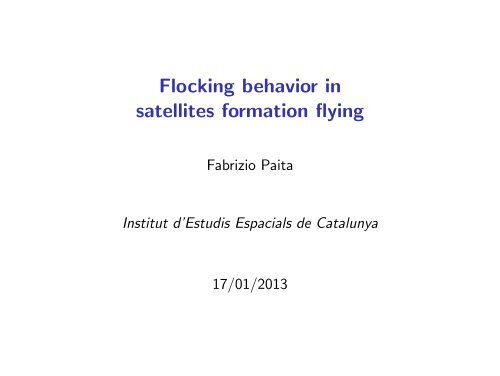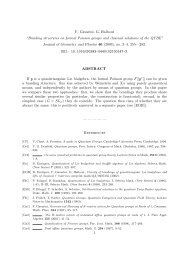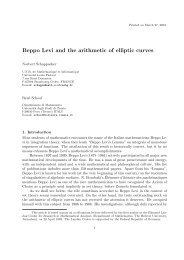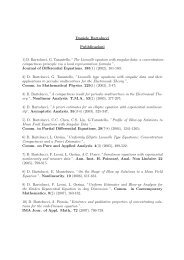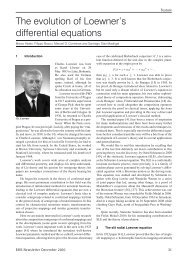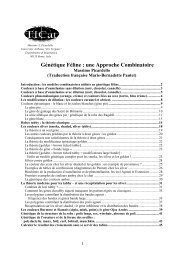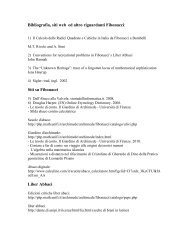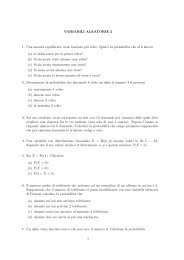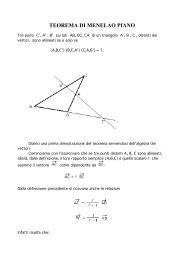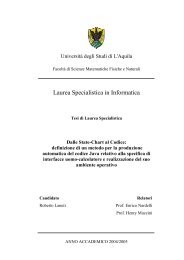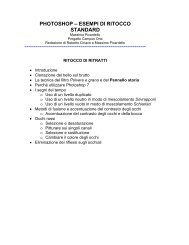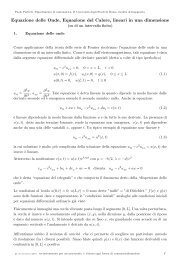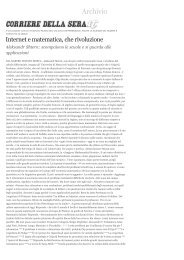Flocking behavior in satellites formation flying
Flocking behavior in satellites formation flying
Flocking behavior in satellites formation flying
You also want an ePaper? Increase the reach of your titles
YUMPU automatically turns print PDFs into web optimized ePapers that Google loves.
<strong>Flock<strong>in</strong>g</strong> <strong>behavior</strong> <strong>in</strong><br />
<strong>satellites</strong> <strong>formation</strong> fly<strong>in</strong>g<br />
Fabrizio Paita<br />
Institut d’Estudis Espacials de Catalunya<br />
17/01/2013
Project overview.<br />
◮ Current objective<br />
Adapt<strong>in</strong>g a particular control law as a tool to develop goal oriented and<br />
collisions free trajectories for flocks of <strong>satellites</strong>, both <strong>in</strong> “ free ” space<br />
and under the <strong>in</strong>fluence of a gravitational field.<br />
◮ The subject<br />
Given a flock of n objects, the equations of motion for the i-th element<br />
under this law can be written as<br />
ẋ = v<br />
˙v = ∑<br />
j∈L(i)<br />
H<br />
(σ + ‖x j − x‖ 2 ) β (v j − v) ,<br />
(1)<br />
where x and v denote position and velocity, L (i) the set of elements that<br />
communicate with agent i and the other variables are positive constants.
Motivations and first steps.<br />
◮ Why this control tool?<br />
In free space, under suitable conditions, a rigid configuration is reached<br />
(same velocity and constant relative distances) exponentially fast.<br />
A hierarchy and a free willed leader can be def<strong>in</strong>ed. Similar results as<br />
above can be obta<strong>in</strong>ed and the dynamics of the <strong>formation</strong> can be directed<br />
through the motion of the leader.<br />
◮ First steps<br />
Numerical implementation of the tool <strong>in</strong> the context of a simple two body<br />
problem, where circular orbits are be<strong>in</strong>g considered.<br />
Relevant parameters which effect is under study <strong>in</strong>clude the shape and<br />
the altitude of the orbits, the effect of the acceleration variables and<br />
<strong>in</strong>itial conditions and the possibility to <strong>in</strong>troduce and manage a hierarchy<br />
between the elements.
Future work directions.<br />
◮ Improvement of the control law<br />
Additional terms can be added depend<strong>in</strong>g on the task required. For<br />
example, terms could be added <strong>in</strong> order to achieve tighter spatial<br />
configurations.<br />
◮ Optimal way to use it<br />
The focus is on apply<strong>in</strong>g the tool as an impulse at discrete times to<br />
ma<strong>in</strong>ta<strong>in</strong> the <strong>formation</strong> and us<strong>in</strong>g a leader to control its dynamics.<br />
◮ Extension and ref<strong>in</strong>ement of the model(s)<br />
As an example, the effect of Earth oblateness on the dynamics of a<br />
<strong>formation</strong> orbit<strong>in</strong>g around it is go<strong>in</strong>g to be considered.
Personal background.<br />
◮ Academical<br />
Bachelor’s and Master’s degree obta<strong>in</strong>ed at the University of Roma “ Tor<br />
Vergata ” .<br />
◮ Research<br />
Construction and analysis of a model for the dynamics of a satellite<br />
around an oblate planet <strong>in</strong> the context of non twist maps, with the<br />
satellite also subjected to the dissipative effect of tides (under<br />
development).


